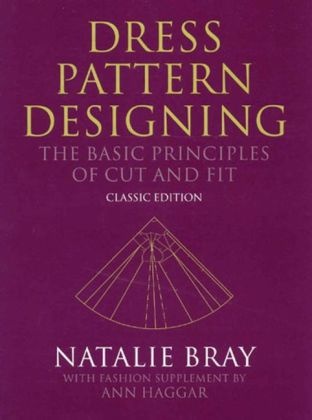Read more
Informationen zum Autor Natalie Bray trained in Paris while connected with a Court dressmaking business in London. The techniques she pioneered and perfected revolutionised dress pattern designing. Her teaching has had a profound influence on design, production and education. Ann Haggar, who wrote the Fashion Supplement, has many years' experience both in industry and in education, and combines her writing with teaching at St Martin's School of Art and with couture. Klappentext This classic book on pattern cutting, by a Paris-trained expert, teacher and examiner has been established for many years as a basic book for students, professionals and enthusiastic amateurs. Over a hundred diagrams and forty plates are combined with clear and detailed instructions for making patterns, so that the practical application of the methods is demonstrated side by side with the theory and basic principles. This book covers the basic course which for many years has been the foundation of all training at the Katinka School of Dress Designing and includes measurement and block patterns, circular patterns, simple pattern designing, yokes, dart manipulation, sleeves, collars and necklines, skirts, and the one-piece dress foundation. This edition also features a Fashion Supplement which offers directions illustrated with forty illuminating diagrams for the following subjects: shirt and jacket blocks for casual wear, shoulder pad allowances, cuff and sleeve openings, pockets, wrap and strap (or placket) openings, and halter necks. Zusammenfassung The techniques Natalie Bray pioneered and perfected revolutionised dress pattern designing! assisting the rise of the modern fashion industry. Her teaching has had a profound influence on design! production and education and her works are classics: fashions change but the principles of designing patterns in the flat do not. Inhaltsverzeichnis Biographical Note. Introductory. Applying the Metric System to Practical Pattern Designing. One. Measurements and Block Patterns. Two. The Bodice Block (bodice Analysis). Three. Using the Bodice Block (Introduction to Pattern Designing). Four. Simple Pattern Designing. FIve Yoke Styles. Six. Dart Manipulation. Seven. Sleeves. Eight. Designing Sleeve Patterns. Nine. Collars. Ten. Necklines, Revers, Rever-collars, Capes. Eleven. Skirts. Twelve. One-Piece Dress Foundation. Thirteen. Designing Skirt Patterns (Gores). Fourteen. Fullness in Skirts: Pleats, Folds, Gathers. Fifteen. Flares. Sixteen. Circular Patterns. Appendix One: The Simplified Bodice Block. Appendix Two. Adjustments to Sleeve. Abbreviations and Reference Letters. Fashion Supplement. Blocks for Casual Wear. Dartless Bodice Block (with Shoulder/Bust Dart Removed). Loose Fitting Shirt Block. Loose Fitting Jacket Block. Simple Kimono and Raglan Blocks. Shoulder Pad Allowances. Cuff and Sleeve Openings. Pockets. Wrap and Strap (or Placket) Openings. Halter Necklines. Index. ...
List of contents
Biographical Note.
Introductory.
Applying the Metric System to Practical Pattern Designing.
One. Measurements and Block Patterns.
Two. The Bodice Block (bodice Analysis).
Three. Using the Bodice Block (Introduction to Pattern Designing).
Four. Simple Pattern Designing.
FIve Yoke Styles.
Six. Dart Manipulation.
Seven. Sleeves.
Eight. Designing Sleeve Patterns.
Nine. Collars.
Ten. Necklines, Revers, Rever-collars, Capes.
Eleven. Skirts.
Twelve. One-Piece Dress Foundation.
Thirteen. Designing Skirt Patterns (Gores).
Fourteen. Fullness in Skirts: Pleats, Folds, Gathers.
Fifteen. Flares.
Sixteen. Circular Patterns.
Appendix One: The Simplified Bodice Block.
Appendix Two. Adjustments to Sleeve.
Abbreviations and Reference Letters.
Fashion Supplement.
Blocks for Casual Wear.
Dartless Bodice Block (with Shoulder/Bust Dart Removed).
Loose Fitting Shirt Block.
Loose Fitting Jacket Block.
Simple Kimono and Raglan Blocks.
Shoulder Pad Allowances.
Cuff and Sleeve Openings.
Pockets.
Wrap and Strap (or Placket) Openings.
Halter Necklines.
Index.

